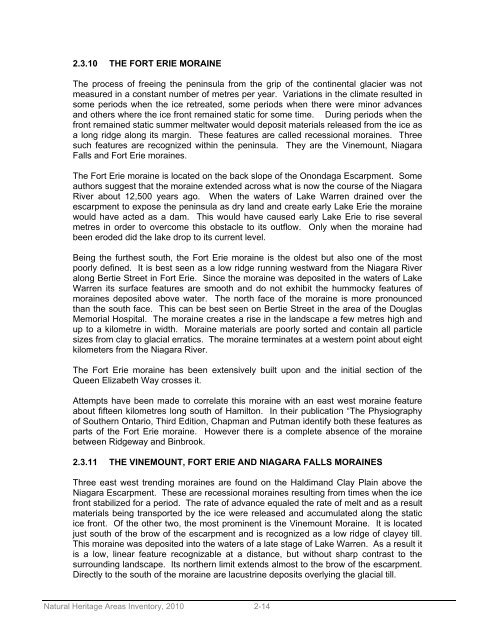2.0 Watershed Geologic Characterization.pdf - Niagara Peninsula ...
2.0 Watershed Geologic Characterization.pdf - Niagara Peninsula ...
2.0 Watershed Geologic Characterization.pdf - Niagara Peninsula ...
You also want an ePaper? Increase the reach of your titles
YUMPU automatically turns print PDFs into web optimized ePapers that Google loves.
2.3.10 THE FORT ERIE MORAINE<br />
The process of freeing the peninsula from the grip of the continental glacier was not<br />
measured in a constant number of metres per year. Variations in the climate resulted in<br />
some periods when the ice retreated, some periods when there were minor advances<br />
and others where the ice front remained static for some time. During periods when the<br />
front remained static summer meltwater would deposit materials released from the ice as<br />
a long ridge along its margin. These features are called recessional moraines. Three<br />
such features are recognized within the peninsula. They are the Vinemount, <strong>Niagara</strong><br />
Falls and Fort Erie moraines.<br />
The Fort Erie moraine is located on the back slope of the Onondaga Escarpment. Some<br />
authors suggest that the moraine extended across what is now the course of the <strong>Niagara</strong><br />
River about 12,500 years ago. When the waters of Lake Warren drained over the<br />
escarpment to expose the peninsula as dry land and create early Lake Erie the moraine<br />
would have acted as a dam. This would have caused early Lake Erie to rise several<br />
metres in order to overcome this obstacle to its outflow. Only when the moraine had<br />
been eroded did the lake drop to its current level.<br />
Being the furthest south, the Fort Erie moraine is the oldest but also one of the most<br />
poorly defined. It is best seen as a low ridge running westward from the <strong>Niagara</strong> River<br />
along Bertie Street in Fort Erie. Since the moraine was deposited in the waters of Lake<br />
Warren its surface features are smooth and do not exhibit the hummocky features of<br />
moraines deposited above water. The north face of the moraine is more pronounced<br />
than the south face. This can be best seen on Bertie Street in the area of the Douglas<br />
Memorial Hospital. The moraine creates a rise in the landscape a few metres high and<br />
up to a kilometre in width. Moraine materials are poorly sorted and contain all particle<br />
sizes from clay to glacial erratics. The moraine terminates at a western point about eight<br />
kilometers from the <strong>Niagara</strong> River.<br />
The Fort Erie moraine has been extensively built upon and the initial section of the<br />
Queen Elizabeth Way crosses it.<br />
Attempts have been made to correlate this moraine with an east west moraine feature<br />
about fifteen kilometres long south of Hamilton. In their publication “The Physiography<br />
of Southern Ontario, Third Edition, Chapman and Putman identify both these features as<br />
parts of the Fort Erie moraine. However there is a complete absence of the moraine<br />
between Ridgeway and Binbrook.<br />
2.3.11 THE VINEMOUNT, FORT ERIE AND NIAGARA FALLS MORAINES<br />
Three east west trending moraines are found on the Haldimand Clay Plain above the<br />
<strong>Niagara</strong> Escarpment. These are recessional moraines resulting from times when the ice<br />
front stabilized for a period. The rate of advance equaled the rate of melt and as a result<br />
materials being transported by the ice were released and accumulated along the static<br />
ice front. Of the other two, the most prominent is the Vinemount Moraine. It is located<br />
just south of the brow of the escarpment and is recognized as a low ridge of clayey till.<br />
This moraine was deposited into the waters of a late stage of Lake Warren. As a result it<br />
is a low, linear feature recognizable at a distance, but without sharp contrast to the<br />
surrounding landscape. Its northern limit extends almost to the brow of the escarpment.<br />
Directly to the south of the moraine are lacustrine deposits overlying the glacial till.<br />
Natural Heritage Areas Inventory, 2010 2-14

















